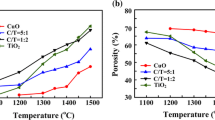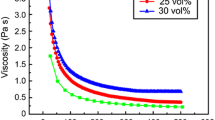Abstract
Directionally aligned prismatic and lamellar porous alumina scaffolds with a high strength-to-density ratio were fabricated from submicron Al2O3 powders and a tiny quantity of nanoscale TiO2 sintering aids by freeze casting using TBA and water as solvents. Both freezing temperature (− 10 °C, − 50 °C, − 90 °C) and sintering temperature (1300 °C, 1350 °C, 1400 °C) were varied to adjust pore parameters while a low solid loading (15 vol%) was maintained to ensure high porosity. This paper describes and compares the microstructures, porosity, pore size, wall thickness and compressive behavior of the scaffolds with two typical pore morphologies (lamella and honeycomb), which help to identify their scope of application and to unveil the relationship between pore morphology and mechanical property to optimize the material performance. The failure modes of these two types of scaffolds under compression were simulated. The TBA-based 1 wt% TiO2-containing alumina scaffolds with dense ceramic walls that were freeze-cast at − 90 °C and sintered at 1400 °C exhibited a compressive strength of 160 MPa with a porosity of 59%, indicating lightweight and high-strength characteristics.










Similar content being viewed by others
References
Colombo P (2008) In praise of pores. Science 322:381–383
Green DJ, Colombo P (2003) Cellular ceramics: intriguing structures, novel properties, and innovative applications. MRS Bull 28:296–300
Souza DF, Nunes EHM, Pimenta DS, Vasconcelos DCL, Nascimento JF, Grava W, Houmard M, Vasconcelos WL (2014) Synthesis and structural evaluation of freeze-cast porous alumina. Mater Charact 96:183–195
Hollister SJ (2005) Porous scaffold design for tissue engineering. Nat Mater 4:518–524
Li Y, Fu ZY, Su BL (2012) Hierarchically structured porous materials for energy conversion and storage. Adv Funct Mater 22:4634–4667
Han YS, Li JB, Chen YJ (2003) Fabrication of bimodal porous ceramics. Mater Res Bull 38:373–379
Boaro M, Vohs JM, Gorte RJ (2003) Synthesis of highly porous yttria-stabilized zirconia by tape-casting methods. J Am Ceram Soc 86:395–400
Sarhadi F, Afarani MS, Kalhori DM, Shayesteh M (2016) Fabrication of alumina porous scaffolds with aligned oriented pores for bone tissue engineering applications. Appl Phys A 122:1–8
Isobe T, Kameshima Y, Nakajima A, Okada K (2007) Preparation and properties of porous alumina ceramics with unidirectionally oriented pores by extrusion method using a plastic substance as a pore former. J Eur Ceram Soc 27:61–66
Deville S, Saiz E, Nalla RK, Tomsia AP (2006) Freezing as a path to build complex composites. Science 311:515–518
Deville S, Saiz E, Tomsia AP (2006) Freeze casting of hydroxyapatite scaffolds for bone tissue engineering. Biomaterials 27:5480–5489
Deville S (2008) Freeze-casting of porous ceramics: a review of current achievements and issues. Adv Eng Mater 10:155–169
Xu TT, Wang CA (2016) Control of pore size and wall thickness of 3-1 type porous PZT ceramics during freeze-casting process. Mater Des 91:242–247
Wang Z, Feng P, Wang X, Geng P, Akhtar F, Zhang HF (2016) Fabrication and properties of freeze-cast mullite foams derived from coal-series kaolin. Ceram Int 42:12414–12421
Guizard C, Leloup J, Deville S (2014) Crystal templating with mutually miscible solvents: a simple path to hierarchical porosity. J Am Ceram Soc 97:2020–2023
Deville S, Saiz E, Tomsia AP (2007) Ice-templated porous alumina structures. Acta Mater 55:1965–1974
Deville S, Bernard-Granger G (2011) Influence of surface tension, osmotic pressure and pores morphology on the densification of ice-templated ceramics. J Eur Ceram Soc 31:983–987
Tang Y, Qiu S, Wu C, Miao Q, Zhao K (2016) Freeze cast fabrication of porous ceramics using tert-butyl alcohol-water crystals as template. J Eur Ceram Soc 36:1513–1518
Liu R, Yuan J, Wang CA (2013) A novel way to fabricate tubular porous mullite membrane supports by TBA-based freezing casting method. J Eur Ceram Soc 33:3249–3256
Smothers WJ, Reynolds HJ (1954) Sintering and grain growth of alumina. J Am Ceram Soc 37:588–594
Bagley RD, Cutler IB, Johnson DL (1970) Effect of TiO2 on initial sintering of Al2O3. J Am Ceram Soc 53:136–141
Silva AMA, Nunes EHM, Souza DF, Martens DL, Diniz da Costab JC, Houmard M, Vasconcelos WL (2015) Effect of titania addition on the properties of freeze-cast alumina samples. Ceram Int 41:10467–10475
Kebbede A, Parai J, Carim AH (2000) Anisotropic grain growth in α-Al2O3 with SiO2 and TiO2 additions. J Am Ceram Soc 83:2845–2851
Bueno S, Hernández MG, Sánchez T, Anaya JJ, Baudín C (2008) Non-destructive characterisation of alumina/aluminium titanate composites using a micromechanical model and ultrasonic determinations: part I. Evaluation of the effective elastic constants of aluminium titanate. Ceram Int 34:181–188
Ojuva A, Järveläinen M, Bauer M, Keskinen L, Valkonen M, Akhtar F, Leväne E, Bergström L (2015) Mechanical performance and CO2 uptake of ion-exchanged zeolite A structured by freeze-casting. J Eur Ceram Soc 35:2607–2618
Hunger PM, Donius AE, Wegst UGK (2013) Structure-property-processing correlations in freeze-cast composite scaffolds. Acta Biomater 9:6338–6348
Choi HJ, Yang TY, Yoon SY, Kim BK, Park HC (2012) Porous alumina/zirconia layered composites with unidirectional pore channels processed using a tertiary-butyl alcohol-based freeze casting. Mater Chem Phys 133:16–20
Han JC, Hu LY, Zhang YM (2009) Fabrication of ceramics with complex porous structures by the impregnate-freeze-casting process. J Am Ceram Soc 92:2165–2167
Yoon BH, Choi WY, Kim HE, Kim JH, Koh YH (2008) Aligned porous alumina ceramics with high compressive strengths for bone tissue engineering. Scr Mater 58:537–540
Shen P, Xi JW, Fu YJ, Shaga A, Sun C, Jiang QC (2014) Preparation of high-strength Al–Mg–Si/Al2O3 composites with lamellar structures using freeze casting and pressureless infiltration techniques. Acta Metall Sin (Engl Lett) 27:944–950
Hu LY, Zhang YM, Dong SL, Zhang SM, Li BX (2013) In situ growth of hydroxyapatite on lamellar alumina scaffolds with aligned pore channels. Ceram Int 39:6287–6291
Liu G, Zhang D, Meggs C, Button TW (2010) Porous Al2O3–ZrO2 composites fabricated by an ice template method. Scr Mater 62:466–468
Zhang D, Zhang Y, Xie R, Zhou KC (2012) Freeze gelcasting of aqueous alumina suspensions for porous ceramics. Ceram Int 38:6063–6066
Tang YF, Miao Q, Qiu S, Zhao K, Hu L (2014) Novel freeze-casting fabrication of aligned lamellar porous alumina with a centrosymmetric structure. J Eur Ceram Soc 34:4077–4082
Zeng J, Zhang Y, Zhou K, Zhang D (2014) Effects of alcohol additives on pore structure and morphology of freeze-cast ceramics. Trans Nonferrous Met Soc China 24:718–722
Chen RF, Wang CA, Huang Y, Ma LG, Lin WY (2007) Ceramics with special porous structures fabricated by freeze-gelcasting: using tert-butyl alcohol as a template. J Am Ceram Soc 90:3478–3484
Fu YJ, Shen P, Hu ZJ, Sun C, Guo RF, Jiang QC (2016) The role of CuO–TiO2 additives in the preparation of high-strength porous alumina scaffolds using directional freeze casting. J Porous Mater 23:539–547
Acknowledgements
This work is supported by the National Natural Science Foundation of China (No. 51571099) and the Changbai Mountain Scholars Program of Jilin Province (No. 2015011).
Author information
Authors and Affiliations
Corresponding author
Rights and permissions
About this article
Cite this article
Sun, MQ., Shen, P. & Jiang, QC. Fabrication and characterization of robust freeze-cast alumina scaffolds with dense ceramic walls and controllable pore sizes. J Mater Sci 54, 5224–5235 (2019). https://doi.org/10.1007/s10853-018-03222-9
Received:
Accepted:
Published:
Issue Date:
DOI: https://doi.org/10.1007/s10853-018-03222-9




